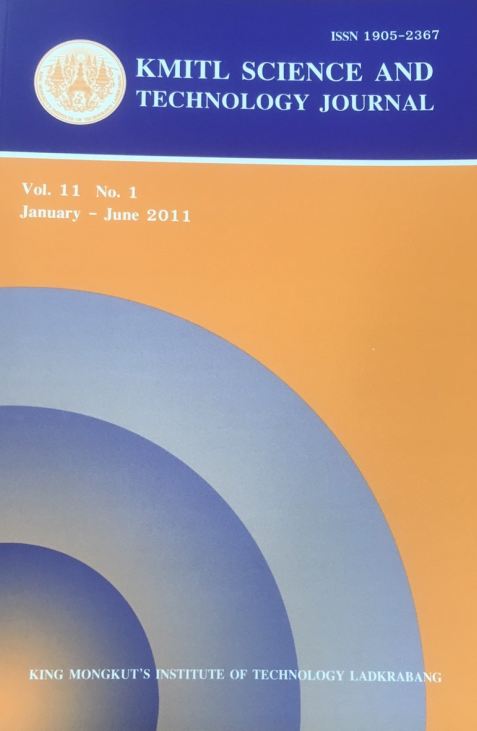Optimal Pre-treatment and Resolubilization of Protease B from Bacillus licheniformis
Main Article Content
Abstract
The study was designed to optimize physical parameters (e.g., temperature, maturation time and pH) related to protein solubility in order to reduce the cost of the total process of the enzyme production at industrial scale. We have studied the influence of physical parameters and chemical pre-treatment on the solubility of Protease B in detail. Protease B, a recombinant proteolytic enzyme produced from genetically engineered Bacillus licheniformis was used in this study. A longer protein solubility region as a function of pH and dry matter percentage was found at 4°C for Protease B. The maximum dry matter percentage was 20.1% RI (Refractive Index). The optimum protein solubility for Protease B solubility was found between 3.0 to 4.0 mS/cm conductivity within a pH range of 4.0 to 6.0. The solubility trend of the protein was not changed by the level of the enzyme concentration. This study clearly demonstrates that optimization of some physical parameters and chemical pre-treatment improves the solubility of Protease B and thus establishes the conditions of parameters in a cost-effective strategy of Protease B recovery and production at industrial scale.
Keywords: Protein solubility, physical parameters, ultrafiltration concentrate, enzyme concentration, enzyme crystal.
*Corresponding author: Mobile: +880-1720478775
E-mail: isti_99@yahoo.com.
Article Details
Copyright Transfer Statement
The copyright of this article is transferred to Current Applied Science and Technology journal with effect if and when the article is accepted for publication. The copyright transfer covers the exclusive right to reproduce and distribute the article, including reprints, translations, photographic reproductions, electronic form (offline, online) or any other reproductions of similar nature.
The author warrants that this contribution is original and that he/she has full power to make this grant. The author signs for and accepts responsibility for releasing this material on behalf of any and all co-authors.
Here is the link for download: Copyright transfer form.pdf
References
[2] Dwyer, J. L. 1984. Bio/Technology, 2, 957.
[3] Bonnerjea, J., Oh, S., Hoare, M., and Dunnill, P. 1986. Biotechnology, 4, 954.
[4] Asenjo, J. A. 1988. The rational design of large scale protein separation sequences. Paper presented at the 196th ACS National Meeting, MBTD division, Los Angeles, 25-30.
[5] Pharmacia, 1983. Scale up to process chromatography. Guide to Design, Pharmacia, Uppsala, Sweden.
[6] Faber, C., Hobley, T., Mollerup, J., Thomas, O., Kaasgaard, S. 2008. Factors affecting the solubility of Bacillus halmapalus α-amylase. Chem. Eng. Process. 47,1007-1017.
[7] Saul, R. T., Scholtz, J. M., Pace, C. N., 2008. Measuring and increasing protein solubility. J. Pharm. Sci. 97,4155-4166.
[8] Retailleau, P., Ries-Kautt, M., Ducruix, A. 1997. No salting-in of lysozyme chloride observed at low ionic strength over a large range of pH. Biophys. J. 71, 2156-2163.
[9] Robert, A., Donahue, Jr., Bebee, R. L. 1999. BL21-SI competent cells for protein expression in E. coli. Focus. 21, 49-51.
[10] Liu, J. W., Boucher, Y., Stokes, H. W., Ollis, D. L. 2006. Improving protein solubility: The use of the Escherichia coli dihydrofolate reductase gene as a fusion reporter. Prot. Expr. Purr. 47, 258-263.
[11] Green. A. A. 1932.Studies in the physical chemistry of the proteins. Phys. Chem. Protein. 10, 47-66.
[12] Green, A. 1931. Studies in the physical chemistry of the proteins. VIII. The solubility of hemoglobin in concentrated salt solutions: a study of the salting-out of proteins. J. Biol. Chem. 93, 495-516.
[13] Green, A. 1931. Studies in the physical chemistry of the proteins. IX. The effect of electrolytes on the solubility of hemoglobin in solutions of varying hydrogen ion activity with a note on the comparable behavior of casein. J. Biol. Chem. 93, 517-542.


